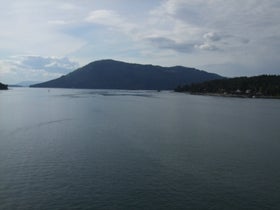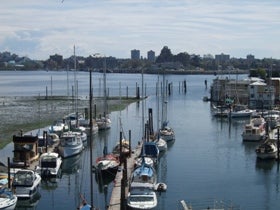 I just read A Cautionary Tale About ITQ’s in BC Fisheries by Ecotrust Canada. What struck me most is that we seem to be moving beyond the debate about whether catch shares provide conservation benefits. It’s clear that they do.
I just read A Cautionary Tale About ITQ’s in BC Fisheries by Ecotrust Canada. What struck me most is that we seem to be moving beyond the debate about whether catch shares provide conservation benefits. It’s clear that they do.
In the paper, Ecotrust affirms the conservation benefits of ITQs, Individual Transferable Quotas, one form of a catch share:
“[ITQs] make fishermen responsible for keeping within an individual catch limit thereby ensuring that the entire fleet stays within a strict TAC [total allowable catch].”
The article goes on to say that, for this reason, ITQs have been good for conservation. It also says that ITQs can increase the economic performance of a fishery.
As catch shares become more common, a close look at particular aspects of catch share design can help create a healthy dialogue about how best to fine-tune the programs. We should aim to optimize conservation benefits while ensuring the highest possible benefits for fishing communities.
 Ecotrust highlights that catch shares have led to increases in the value of fisheries. Significant societal benefits are associated with these changes, including providing fishermen and crew with more stable jobs; providing opportunities for creative business innovations; more highly valued seafood; and increased investment in modernizing fishing boats and gear. However, Ecotrust focuses on the economic impacts on a specific group of stakeholders in fisheries: primarily fishing crews. Ecotrust’s central complaint is that the practice of leasing quota share disadvantages British Columbia fishing crews, compared to share owners or other stakeholders.
Ecotrust highlights that catch shares have led to increases in the value of fisheries. Significant societal benefits are associated with these changes, including providing fishermen and crew with more stable jobs; providing opportunities for creative business innovations; more highly valued seafood; and increased investment in modernizing fishing boats and gear. However, Ecotrust focuses on the economic impacts on a specific group of stakeholders in fisheries: primarily fishing crews. Ecotrust’s central complaint is that the practice of leasing quota share disadvantages British Columbia fishing crews, compared to share owners or other stakeholders.
The design of any fishing regulation should be as fair as possible with regard to participation by all of society in the economic upside of well-managed fisheries. Most unfair of all would be to continue managing our fisheries on an unsustainable course.
The paper points to specific solutions to the concern of fairness in catch shares: including community hold backs, direct community allocations, owner-on-board requirements, territorial use rights and other mechanisms. EDF has advocated and even pioneered these types of tools in past and current catch share design processes. Our goal, which we share with Ecotrust and many other fishery stakeholders, is to maximize the positive socio-economic outcomes and minimize the negative ones — once conservation performance is assured.










One Comment
Dear Johanna,
Ecotrust Canada’s motivation for publishing a “Cautionary Tale about ITQ Fisheries” stems from the fact that some industry and environmental groups — including EDF — exaggerate the importance of catch shares in sustainable fisheries and have ignored or downplayed their negative side. Your blog posting makes our report sound like a glowing reference for ITQs and minimizes our critique of some fundamental problems as experienced in British Columbia, Canada.
We are also not in agreement that catch shares alone will conserve fish stocks: other factors, like restricting destructive gear, ensuring proper enforcement and stock assessment, are perhaps even more important. In fact, we have seen fish stock declines in catch share fisheries in BC, including abalone, halibut and hake.
A proper and more balanced reading of our report would suggest that, as implemented in BC, catch shares have created huge market distortions and have missed the mark in achieving a number of objectives. Specifically, EDF promotes catch shares because:
1. Catch shares “give fishermen a financial stake… in fisheries.”
In BC, those initially gifted catch shares have become the owners of the resource, but many have decided to lease their quota instead of fishing it themselves. In the halibut fishery, 100% of the quota is leased. Lease fees often consume 70 to 80 percent of the landed value of the catch. The lucrative leasing has pushed up the price of quota and now new entrants or fishermen with little quota are unable to purchase it and are forced to continue leasing. Ironically, in BC, catch shares have had the opposite effect of encouraging ownership. In the future, fewer working fishermen will have a financial stake in fisheries; that’s especially true for new entrants who now lease other people’s expensive quotas.
2. Catch shares “improve fishing safety.”
The high cost of leasing quota bleeds income away from working fishermen, both captains and crews, forcing vessels to go to sea with inexperienced or insufficient crew. There is considerable anecdotal evidence that vessels in the trawl fishery, which became a catch share fishery in 1997, are fishing with fewer crew as a result. Safety statistics, particularly the number of fatalities on trawlers, suggest the groundfish trawl fishery has become less safe after the introduction of catch shares. Longline fishermen are also airing similar complaints about crew shares and the lack of money to properly maintain vessels.
3. Catch shares “increase profits.”
Profits for who? Many fishermen in BC are complaining that despite high prices for fresh fish few of them are profiting from BC’s sustainable fisheries. Leasing fees for catch shares take up to 70 to 80 percent of the landed value, leaving very little for working fishermen. In 2008, fishermen formed the BC Longline Fishermen Association (http://www.bclonglinefishermen.com) to reform the catch share fishery because of acute financial problems.
“As we know,” writes the group’s leader Art Davidson, “the B.C. Hook and line Groundfish Fishermen are in a desperate state and if nothing is done soon the fleet will be operating under unsafe conditions and experienced crew will be non existent. It is time to take action to make the industry viable to ensure upkeep of the vessels and to pay our crew a fair wage to reflect the demands of the work and the sacrifices they make.”
What can be done? Both Ecotrust Canada and Ecotrust have been working on solutions to these many problems. The U.S. Fisheries Management Councils should support community structures such as Community Trusts (e.g. the Cape Cod Fisheries Trust), Community and Regional Fishing Associations as permitted by the Magnuson-Stevens Fisheries law, and other examples from British Columbia, such as The Pacific Coast Fishermen’s Conservation Company and Groundfish Development Autority. These structures can address many of the problems elucidated in our study, including high debt loads for new entrants, high lease rates, and so on.
I encourage all those with an interest in American fisheries and fishing-dependent communities to read Ecotrust Canada’s report carefully so that you don’t repeat the same mistakes with catch shares that have left many BC fishermen in a “desperate state.”
Regards,
Eric Enno Tamm
eric@ecotrust.ca
Communications Manager
Ecotrust Canada